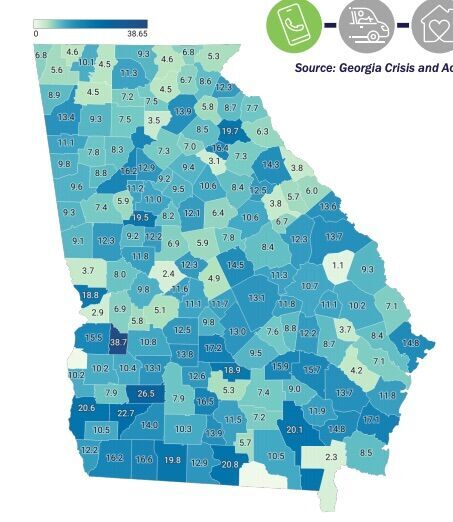Rural Ga. sees 988 demand
Published 9:00 am Tuesday, September 13, 2022

- The map shows the prevalence of 988 crisis calls in Georgia.
ATLANTA — In the first 45 days since the nationwide launch of the 988 crisis hotline, as expected, Georgia health officials reported that calls for assistance have increased – particularly in rural areas of the state.
While total volume of crisis episodes came from the state’s most populous areas, such as metro Atlanta, rural counties had a higher prevalence of episodes per population.
“This data is preliminary. We’re going to continue to look at it, but for the first 30 days, there were more cases in south rural Georgia than other parts of the state,” said Dawn Peel, director of the state’s Crisis Coordination. “One of the interesting things to consider when you think about rural rates is that in 2020, the rural suicide rates increased by 8.3%, while they decrease to some degree in urban areas.”
In Webster County, people reached out at twice the rate of the number of people who reached out in Fulton County, according to data.
Dougherty, Baker, Lowndes, Early, Ware and Thomas counties were also among the top counties that reached out for mental health and substance abuse crisis support at the highest rate.
On July 17, the new easier-to-remember 988 replaced the National Suicide Prevention Lifeline, 1-800-273-8255(TALK), which is still available; the Georgia Crisis and Access Line, 1-800-715-4225, is also still operational to handle crisis calls in the state.
Since the launch of the 988 crisis line for mental health and substance abuse, Georgia’s crisis lines received 37,561 calls, texts or chats through Aug. 29, according to the {span}Georgia Department of Behavioral Health & Developmental Disabilities.{/span}
During July 16 to Aug. 29, 2021, total contacts were 32,843.
“If you compare (with the) same time period in 2021, you’ll see that there’s been a significant increase in call volume between July 16 and Aug. 29,” said Anna Bourque, director of the office of provider relations and ASO coordination. “You see that a lot of that call volume increase comes from 988 (27.61%), still majority come through (GCAL). But we are watching the trend to ensure that as 988 implementation continues to be realized that we’re able to look at the impact and then be able to continue to meet the need.”
The state has only engaged in targeted marketing for the 988 line but health officials anticipate a larger increase in 988 usage when mass marketing begins July 2023.
So far, 30% of contacts are resolved via phone and typically result in referrals or information. Nearly a quarter of the calls, 24%, needed mobile crisis team or 911 response.
Mobile crisis teams are typically dispatched when onsite crisis management is needed for evaluations, deescalation, consultation or referrals to outpatient or impatient services.
In the first 30 days of the 988 rollout, there were more than 1,900 mobile crisis response dispatches in Georgia.
Federal protections suggest that the demand for mobile crisis services could increase by as much as 176% when mass marketing of 988 begins next year.
A large percentage (46%) of the calls received since the 988 launch in Georgia, resulted in the need to go to a health facility, such as a behavioral health crisis stabilization unit, behavioral health crisis center or an inpatient referral to a hospital.
During the first 30 days of the 90-day rollout, there were more than 4,100 community crisis bed referrals. Once national mass marketing of 988 begins in July, federal projections suggest the need for community crisis beds could increase by 105% during the first year, Peel said.
“What that means for Georgia is that we would need to increase our community crisis capacity by 500 beds or chairs. and that increase is inclusive of both child adolescent crisis stabilization beds, adult crisis stabilization beds and temporary observation chairs for adults in our behavioral health crisis centers,” Peel said, noting the shortage of workforce in the health care industry.
Of most calls that result in the need to go to a facility, majority are voluntary; only 1% of people who call and get a mobile crisis response result in a 1013 or an order for an involuntary evaluation, Peel said.
“And that’s only when they’re at risk to themselves or others,” Peel added. “Our teams work really, really hard to find any other option that is safe and appropriate for people as opposed to an inpatient facility or an involuntary evaluation order or a 1013. There are times when mobile crisis goes out and does evaluation and can deescalate the person and refer them to outpatient services.”
Other statistics since the 988 rollout, per DBHDD:
– Nationally, males make up 49% of the population, but 80% of the completed suicides; males were 53% of calls to GCAL.
– Emergency room visits for youth and young people grew by 24% for youth ages 5 to 11, during the pandemic, and by 31% for youth ages 12 to 17, according to info from the Centers for Disease Control. In first 30 days of 988 rollout, 10% of calls in Georgia were from people younger than 18 years old.
– At it pertains to race, 27% of the calls were from white or Caucasian people, 30% were from Black or African American, and 40% were unknown or unreported.
“Since 2020, suicide attempts and deaths by suicide for the African American population have increased. and in 2019, suicide was the second leading cause of death for African Americans aged 25 to 14,” Peel said.
– Of the total crisis line calls received since the 988 launch, 10% of calls came from outside of Georgia and 10% refused to give a location.
– In Fiscal Year 2022, there was an average 8.5 of active rescues was per day, or calls where concerns about immediate health and safety may prompt a reroute to 911 for police and/or EMS response for transport. In the first 45 days of the 988 rollout, that number increased to 10.5.
“Georgia crisis and access line gets on average, about 800 calls a day. So as we think about 10.5 active rescues per day, that number is a very, very small proportion of the overall calls that are coming in every day,” Peel said.
DBHDD sets goals for crisis lines
According to data from Vibrant Emotional Health, the administrator of the National Suicide Prevention Lifeline, Georgia is among 23 states that have a crisis center call answer rate of less than 70%.
Of the more than 14,200 crisis calls that were received in Georgia between Jan. 1 to March 31, 66% were answered in-state, with the other calls directed to out-of-state call centers.
Monica Johnson, director of the state’s Division of Behavioral Health, said by 2023, the goal is to have 90% or more of all calls received answered in state; DBHDD also aims to have 80% or more of the callers with access to rapid response by 2025, and 80% or more individuals will have access to community-based crisis care by 2027.
Though sill early in the launch, 97% of the calls to 988 received in-state are being answered in-state and being answered on average in 7.4 seconds. Among calls of all the state’s crisis lines, the average answer rate is 14.8 seconds.





